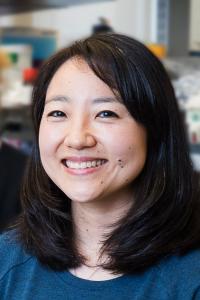Minoree Kohwi, PhD
- Assistant Professor of Neuroscience

Overview
Academic Appointments
- Assistant Professor of Neuroscience
Languages
- Japanese
Gender
- Female
Credentials & Experience
Education & Training
- PhD, Neuroscience, University of California, San Francisco
- BS, Biology, California Institute of Technology
Honors & Awards
- 2015 - Rita Allen Foundation Scholar
- 2015 - Whitehall Foundation Grant
- 2012 - K99/R00 Pathways to Independence Award, NICHD
Research
The brain’s complexity is apparent from the incredible diversity in its cell types. To form the functional circuitry necessary to achieve sophisticated cognitive and motor functions, neural progenitors must make each type of neural cell at the right place and time and also in the correct proportions. The major goal of my lab is to understand the origin of this cellular diversity in the brain and the logic by which it is generated in such a highly organized manner.
A relatively small pool of neural progenitors generates diverse cell types sequentially by responding to changes in cell intrinsic and extrinsic signals. Over time, they lose the ability, or “competence,” to make cell types born at earlier stages and gain competence to make cell types born at later stages. How competence is regulated during development is poorly understood, but has important implications in our basic understanding of brain development, origin of neurodevelopmental disorders, and how we can harness stem cells for brain repair.
The Drosophila Neuroblast system
The Drosophila embryo provides an ideal model to study neural progenitor competence in vivo: there are only ~30 neuroblasts, the fly neural progenitors, in the embryonic nerve cord, and each gives rise to a unique lineage of neurons and glia in an invariant birth order. One of the amazing features of neuroblasts is that each neuroblast and its progeny can be individually identified and tracked over time in vivo. This allows us to reproducibly find the same single progenitor between animals and across development. Critically, the set of transcription factors that specify fate of the neural progeny based on birth order, called “temporal identity factors,” is known and can be exploited to test the neuroblasts’ competence to produce each type of neuron over development.
Mechansisms of neuroblast competence restriction
Using a combination of genetics and DNA FISH (Fluorescence in situ hybridization), we recently discovered that neuroblasts undergo a developmentally-timed reorganization of their genome that physically relocates genes within the nucleus (Kohwi et al., Cell 2013). Genes harbor specific positions relative to various functional compartments within nuclei that can affect whether they can be turned on or off. We discovered that such gene repositioning occurs in neuroblasts in a highly regulated manner, and consequently, determines whether a specific neural cell type can be made at a specific developmental stage. Thus, this restructuring of nuclear architecture appears to regulate the neuroblasts’ competence state (Kohwi and Doe, Nature Rev Neurosci 2013). Current projects focus on understanding how the timing of genome reorganization in neuroblasts is controlled, investigating how the reorganization affects neuroblast output, and translating our findings in the fruit fly to the mouse model system.
(photo credit: Barbara Alper/Columbia University)
Research Interests
- Cell Specification and Differentiation
- Neural Degeneration and Repair
- Stem Cell Biology
Grants
NIH Grants
MECHANISMS UNDERLYING LOSS OF NEURAL STEM CELL COMPETENCE
Project Dates: 1-APR-2014 to 31-MAR-2017
Selected Publications
Kohwi M and Doe CQ. Temporal fate specification and neural stem cell competence. Nat Rev Neuroscience. 2013 Nov 20; 14(12):823-38. PMCID: PMC3951856
Kohwi M, Lupton JL, Lai SL, Miller MR, and Doe CQ. Developmentally-Regulated Subnuclear Genome Reorganization Restricts Neural Progenitor Competence in Drosophila. Cell 152:97-108. Jan 17th, 2013. PMCID: PMC3670710
Manning L, Heckscher ES, Purice MD, Roberts J, Bennet AL, Kroll JR, Pollard JL, Strader ME, Lupton JR, Dyukareva AV, Doan PN, Bauer DM, Wilbur AN, Tanner S, Kelly JJ, Lai SL, Tran KD, Kohwi M, Laverty TR, Pearson JC, Crews ST, Rubin GM, and Doe CQ. Annotated embryonic CNS expression patterns of 5000 GMR GAL4 lines: a resource for manipulating gene expression and analyzing cis-regulatory modules. Cell Reports 2012 Oct 25; 2:1002-13. PMCID: PMC3523218
Kohwi M, Hiebert LS, and Doe CQ. The pipsqueak-domain proteins Distal antenna and Distal antenna-related restrict Hunchback neuroblast expression and early-born neuronal identity. Development 2011 May 138(9):1727-35. PMCID: PMC3074449
Alvarez-Buylla A, Kohwi M, Nguyen TM, Merkle FT. The heterogeneity of adult neural stem cells and the emerging complexity of their niche. Cold Spring Harb Symp Quant Biol. 2008; 73:357-65. PMID: 19022766
Kohwi M, Petryniak M, Long J, Ekker M, Obata K, Yanagawa Y, Rubenstein J, Alvarez-Buylla A. A subpopulation of olfactory bulb GABAergic interneurons is derived from Emx1 and Dlx5/6-expressing progenitors. J Neurosci. 2007 Jun 27;27(26):6878-91. PMID: 17596436
Kohwi M, Galvao RP, Alvarez-Buylla A. Birth, migration and function of SVZ derived neurons in the adult brain. Chapter 3 in Mammalian Subventricular Zone: Their roles in brain development, cell replacement and disease. Levinson S edit 2005
Kohwi M, Osumi N, Rubenstein JL, Alvarez-Buylla A. Pax6 is required for making specific subpopulations of granule and periglomerular neurons in the olfactory bulb. J Neurosci. 2005 Jul 27;25(30):6997-7003. PMID: 16049175
For a complete list of publications, please visit PubMed.gov